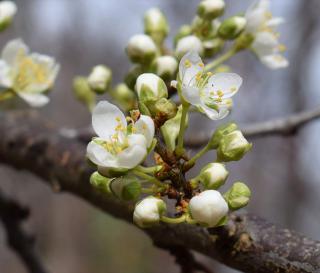

Cherry trees are among the most common fruit trees found in our orchards.
Key Cherry tree facts
Name – Prunus cerasus
Family – Rosaceae
Type – fruit tree
Height – 20 to 50 feet (6 to 15 meters)
Exposure – full sun
Soil – ordinary
Foliage – deciduous
Flowering – April
Harvest – May to July depending on the variety
Planting, pruning and caring for cherry tree are all practices that will let you grow a bountiful cherry harvest.
Planting a cherry tree is an important step because, if properly performed, it favors the expected growth of the tree, fruit formation on the cherry tree and thus the harvest of cherries.
The better it is planted, the earlier it will produce luscious cherries.
This is a topic that is quite divisive, because pruning a cherry tree tends to weaken the tree and increase its vulnerability to many diseases.
Nonetheless, it might still be necessary to prune if the cherry tree grows too large, or if certain branches become too weak.
A cherry tree is considered to be a very sensitive tree. Its sensitivity explains why pruning must be avoided as much as possible: each wound is an entry point, for fungus especially.
Ah, the devastation that birds can wring on the cherry tree…
They can leave you empty handed, having devoured your harvest in only a few days.

If you only plant one specimen, select a self-pollinating variety lvike ‘Bigarreau summit’ or ‘Bigarreau sweetheart’ for your desserts and preserves.
The ‘Bigarreau’ cherry tree is a sure choice among all the cherry tree varieties. Take note of the most common Bigarreau sub-varieties, like the ‘Burlat’, the ‘Coeur de Pigeon’, ‘Esperen’, ‘Hedelfingen’, ‘Napoleon’, ‘Rainer’, ‘Reverchon’, ‘Stark Hardy Giant’, ‘Summit’ and ‘Van’.
Your only option is to plant a self-pollinating variety when there will only be one cherry tree, if not, you won’t have any cherries.
You can also choose to plant a ‘Montmorency’ cherry tree, its fruits are perfect for delicious clafoutis that will surprise and delight your children and guests.
Unavoidable in our gardens for those who like to grow fruit trees or want to start an orchard, a cherry tree boasts many advantages.
It has a magnificent late blooming that leads to high fruit formation rates.
Cherries from edible cherry trees are fleshy, sweet and packed with vitamin C, but some of the other innumerable varieties produce fruits that can be extremely sour, or huge, or more or less sweet.
Cherry trees adapt to virtually any climate, and only requires little care, not even dedicated watering.
Growing cherry trees is easy, so go ahead and try!